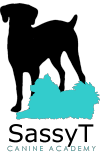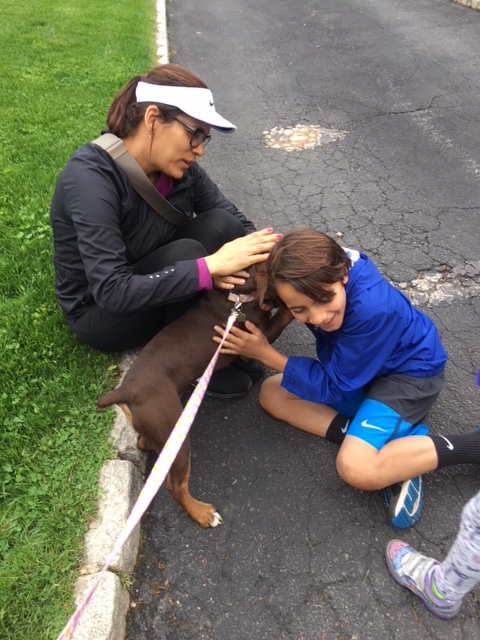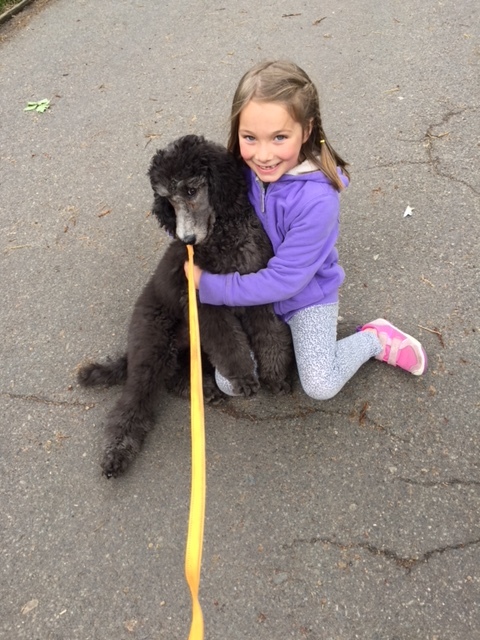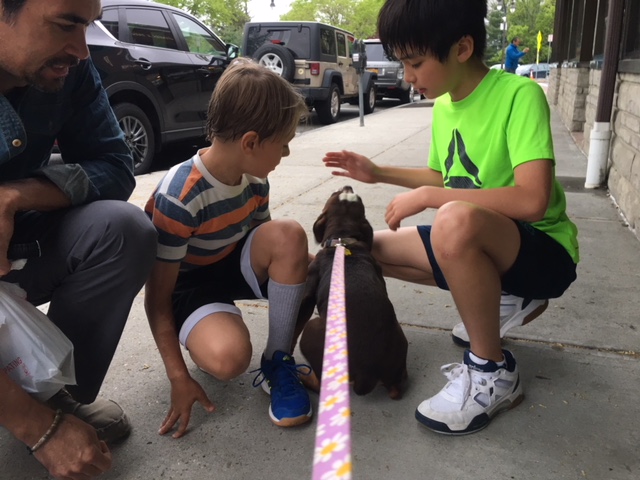It’s going nicely in practice, but in the meantime, what should we do when we’re actually walking our dog?
Waiting for the food dish....is it really teaching anything?
This is an exercise everyone seems to agree is a good thing to teach our dogs. But besides being a cute party trick, is it really teaching anything useful?
So many people think their dog knows how to stay, as evidenced when they do this exercise. And then they are disappointed when the dog cannot stay while visitors arrive, while cooking or eating meals, or during whatever temptation is rearing it’s ugly head.
This exercise in it’s most simple form is no more useful than a party trick.
It is just the tip of the iceberg to teaching humans to teach dogs basic impulse control. If you want to really teach your dog to stay in the face of distractions, try adding these layers of difficulty to the basic exercise:
For ALL exercises:
Easy version: ask puppy to sit.
Hard version: wait for puppy to sit voluntarily.
Super hard version: refrain from saying say stay/wait. Voluntary behavior teaches more self-control.
If bowl gets to the ground with a politely-sitting puppy/dog:
Easy: say “free!” and let puppy eat
Medium: count to 20, then say “free!” and let puppy eat
Hard: count to 40, then say “free!” and let puppy eat
Super difficult: count to 20, ask for down, then say “free!” and let puppy eat.
Whoa, impressive: count to 20, ask for sit/down/sit/touch, then say “free!” and let puppy eat.
PHD level: step behind dog and ask for a touch, then say “free!” and let puppy eat.
Now we’re REALLY talking self-control: apply exercise to exiting crates, cars, or any place where patience is preferred.
happy training! <3 from Jenn, Terra & Ringo
Attention: build it, value it
Why train it?
Because getting your dog’s focus with a single effort is very useful. You can distract him from enticing trash in the street, for example, or keep his eyes on you when walking past another dog. You can more easily get your dog to come when called if you can get his attention. Plus, dogs that are rewarded for paying attention do it more. And attentive dogs are easier to train.
A gateway to self-control
Exercises 1-4 progress from most simple (for dog and human) to most difficult. The more difficult exercises install more self control in your dog. Depending on the difficulty of a given environment, you might decide to gather your dog’s attention in different ways. Work on each exercise in five different locations to make sure your dog can respond to his attention cues in new places and with new distractions.
How to teach it:
Exercise 1. Watch Me: Start with a treat held right at your dog’s nostrils, then draw it to your face, holding it between your eyes. If your dog looks at your face, click and treat. Progress to adding the verbal cue, “Watch Me” when you can make the movement without food in your hand.
Exercise 2. Helper Sound: Use an interesting noise to cause your dog to look at you. Click and treat.
Exercise 3. Name Recognition: When your dog is looking at the environment, say her name cheerfully only once. Click and treat when she looks at you. If she doesn’t, use a helper sound, then click and treat.
Exercise 4. Voluntary Check-In: In a low-distraction area, stand still and quiet. Wait for your dog to voluntarily look up at your face. Click and treat. To add difficulty, add distractions or movement, or play the game in different positions (sit/down/left heel/right heel).
Important Tips:
You will need to teach all humans around your dog to minimize over-use of her name. You really, truly CAN wear out a dog’s name! We are teaching her that her name has value, so using it unnecessarily often undermines this process.
Balance the value of your treat against the value of the nearby distractions. Use simple dog food if no one’s around, and high-stakes cheese or liver in the face of squirrels or other dogs!
Distractions can help or harm this process. Always start at a distance from your dog’s distractions. It should take less than 3-5 seconds to gather her attention. If it takes longer, move further from the distractions and try again. If she’s staring incessantly at you, work closer to the distractions.
STCA's Favorite Calming Supplements
Supplements to support behavior change
These over-the-counter products can be used separately or together. By helping your dog be calmer, less reactive, and less anxious, your training will progress more quickly, with more permanent long-term change. Don’t reach for them as a last resort! Using them in conjunction with a well-planned and well-executed desensitization and counter-conditioning program can really help improve your dog’s overall stress level, making him/her more receptive to training exercises.
Vitamin B
Stress (both positive and negative) quickly depletes B vitamins, so help your dog stay stocked up on this. Most dog foods do not have enough, especially when you consider that Vitamin B is easily destroyed by high heat. Guess how your dog’s food is cooked? Try Amino B-Plex by Rx Vitamins for Pets.
Milk-Protein Based Calming Supplements
These milk-protein-based calming and anxiety-reducing supplements are safe to give everyday. Terra used Zylkene for years and it really made a dent in her general high arousal and sound sensitivity. Ringo swears by Composure for when his separation anxiety creeps up. These consistently get rave reviews from my students and are very easy to feed.
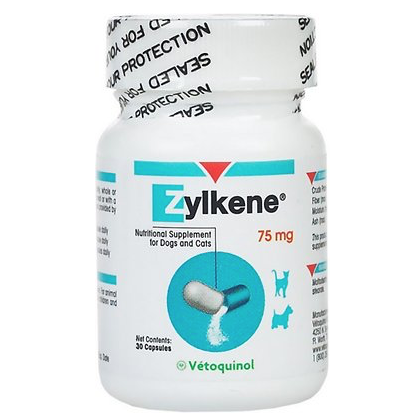

DAP Solutions
DAP stands for Dog Appeasing Pheromone. These solutions emit a dog-appeasing pheromone that mimics natural comforting pheromones emitted by nursing mother dogs. You can get it in a spray form to put in the crate, the car or on a bandana for your dog to wear. You can get it in a diffuser for the whole house. Or get it in a collar that your dog wears full time!
Calming Ingredients in Treats
Look for ingredients like passionflower, chamomile, skullcap, valerian root, or melatonin. Lots of brands sell calming treats these days, so you’ll want to look for good quality overall ingredients and calming ingredients in amounts that will actually make a difference. Here are some to consider:
Ultra-Calm by Drs Fosters and Smith
Rescue Remedy by Bach
Calming Bites by Zesty Paws
Pet Calm by Richard’s Organics
SmartCanine Calming by SmartPak
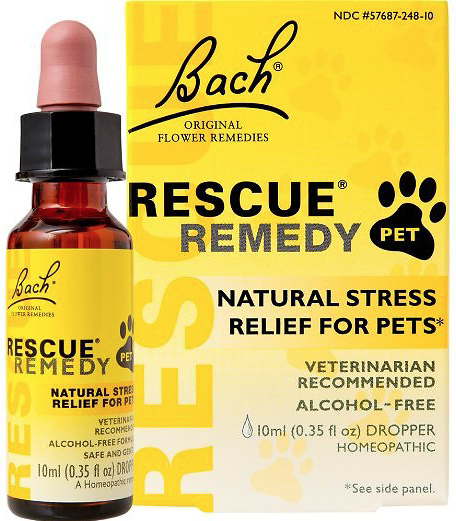

Why your dog doesn't come when called...
Is it an attention problem or a motivation problem?
Springtime is here and most of us respond to the warmer weather by taking our dogs out more often. If we are lucky, we get to take our dogs to places where they can run around off-leash and truly indulge in their ultimate dog-dom. Before summer hits full-swing, spring is a perfect time to spiff up your dog’s ability to come when called. But what if he doesn't come?
Do you have an attention problem or a motivation problem?
There are two main components of a successful recall: your ability to get your dog’s attention and your dog’s interest in returning to you. We often focus on one of these components and neglect the other. These are two sides of the same coin, and to truly have the best recall, we need to strengthen both independently.
If your dog doesn’t even turn around to look you when they hear “Come!” you have an attention problem. If your dog turns to look at you, but doesn’t move toward you, you have a motivation problem.
Attention
Can you get your dog to stop and look at you from 50-100 feet away?
Name recognition is the first step to a solid recall. Obedience classes are full of attention exercises, only trained on a 6-foot leash, so many people think they have name recognition when they really don’t. By practicing it daily, in varying situations, and always pairing with high-value rewards, you can truly build reliability and value in name recognition in ways that will benefit a solid recall. This is important because almost all recalls happen when the dog is off-leash and more than 6 feet from you.
Ways to practice attention for recalls:
- Dog is stationary, 10 feet from you.
- Dog is stationary, 20-50 feet from you.
- Dog is stationary, 100 feet from you.
- Dog is stationary and sniffing
- Dog is facing away, moving slowly.
- Dog is facing away moving quickly.
- Dog is running full speed
- Dog is engaged in play/interaction
These are often ways that we want to practice our recalls, but it’s an important way to practice your dog’s name recognition. Calling a dog can often put a dog into conflict, since we are calling them away from something they are interested in. Focusing on rewarding name recognition before calling the dog allows us to build value in turning to look at you for more information. This behavior will ultimately benefit our recalls, and it doesn’t put the dog into conflict because you’re not asking him to leave an interesting activity. In training terms, this is called splitting criteria. We are separating the goal behavior into small attainable pieces and training those pieces individually.
Does your dog run to you full-tilt when they hear the word "Come" ?
Motivation
So now that your dog is responding to his name in distracting situations, we need him to come running at full speed when he hears “Come!” Resolving motivation issues can drastically improve recall issues, so it’s important to know why you might have a motivation problem. Oftentimes students wait until their dog is at the dog run to practice their recalls, and this automatically puts the dog into conflict: Should I come to owner or play with friends? Starting with lots of practice in easy environments and high-value rewards will reap the most benefits, since it minimizes conflict. Also make sure to only furnish rewards after your dog has come to you, not showing them the treat or toy first. Think paycheck, not bribe. Plastic treat-baggie sounds and hands that hover near treat-pockets are bribes, and it will hurt your dog’s recall reliability if they get tuned into it before actually coming to you.
Reasons your dog isn’t motivated:
- Your rewards are low-value
- Not enough daily practice
- Over-use & desensitization of recall word
- Compliance leads to something dog dislikes (ie: leave dog park, come in house, give up sock)
Summary
Next time your dog doesn’t come to you, diagnose the issue by deciding if your dog had trouble with attention or motivation. This will help you focus your next training session and you’ll be well on your way to better recalls!
Socialization Project, AKC STAR Puppy Class, May 2018
CHECK OUT THE SOCIALIZING YOUR FELLOW STUDENTS ARE DOING:
- Toby saw a school bus!
- Watson went to the library, a cafe, and Central Park!
- Elsie went to the train station, skate park and tennis courts!
- Daisy met the gardener, kids and saw a skateboarder!
- Suki saw lots of things with wheels!
The average puppy needs 3-4 field trips EVERY WEEK to NEW places to become adequately socialized.
If done correctly (NOVEL situations are PAIRED W/TREATS) socializing will help the friendliness and confidence they show as a puppy last and solidify as they become adults. Wariness and avoidance are natural survival instincts that will kick in as the dog ages, potentially causing shyness, fear, and aggression. Socialization helps reduce this natural tendency!
Your puppies need to meet an average of 25 new people every week, and an average of 8 new dogs every week. Let people know that you are there to socialize, bring your treats, and reward and praise every polite interaction your dog has. Don't take for granted a puppy's natural curiosity at this stage. It starts to fade by the time they are 14 weeks old!
REMEMBER THERE ARE THREE PUPPY PRIZE PACKS TO WIN BY SOCIALIZING YOUR PUPPY:
- Puppy with the most completed socialization lists: Dr Sophia Yin and Scavenger Hunt
- Puppy who turns in the most numerous photos socializing with people
- Puppy who turns in a photo of the most unique or interesting socializing situation
Teach your dog to trim his OWN nails!
Does your dog dislike nail trims?
Here's a great winter project for you: teach him to trim his own! This is great for easy maintenance of his front paws; it's fun for both of you! And if you're really talented, you can teach him to scratch his back ones too!
Socialization Project, AKC STAR Puppy Class, January 2018
AKC STAR Puppy Class, Fall 2017
Buying the Perfect Home for You and Your Dog
For many dog owners, searching for a house involves more than scoring the perfect home for their family’s needs. It also involves finding the ideal home for their precious pooches. If you’re house hunting and own a dog, consider some of these tips to help you buy a home that both you and Fido will love.
